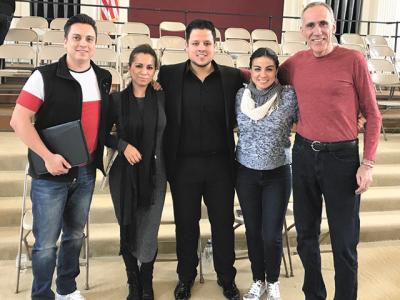Rossini’s Mass: A Delightful ‘Sin of Old Age’

Why would a highly successful composer who hadn’t written any music in over 30 years decide to write a piece in a genre he had never before attempted, one that would provide little income and do little or nothing to burnish his formidable and enduring reputation? While there may never be a satisfactory answer to this question, the audience at Sunday’s performance by the Choral Society of the Hamptons was left with both a mystery to ponder and music to savor.
Gioachino Rossini described his “Petite Messe Solennelle” as the last of his “sins of old age,” and the guest conductor, John Daly Goodwin, led the chorus, soloists, and keyboard players in a thoughtful, intelligent, and highly satisfying performance of this tuneful setting of the Mass, a setting neither solemn nor petite.
Compared to the libretti of opera buffa, the Mass offers almost nothing in the way of drama, but Rossini recognized and took full advantage of the inherent expressive opportunities in the text. Under Mr. Goodwin’s sure direction, the performers were guided in ways that ensured that no opportunity was missed, starting with the Kyrie and its ancient and poignant plea for mercy. Mr. Goodwin had clear ideas concerning articulation, dynamics, and phrase shape, all of which were clearly communicated to his singers, whose eye contact with their director, especially in the opening Kyrie, resulted in well-executed singing and expressive music-making. In the Christe section, which was supposedly composed by a friend of Rossini’s and sounded more like the music we usually associate with Mass settings, Mr. Goodwin wisely chose to double the vocal parts on the organ, as the challenges of singing an extended a cappella section and remaining on pitch for the return of the instrumentalists is a formidable one.
Mr. Goodwin opted for a performance in a version of Rossini’s original scoring for two pianos and harmonium, using just one piano and the church’s organ. Rossini had also called for just 12 singers and, although the piano was always present, the organ part was occasionally lost in the vocal-heavy balance.
The Gloria following the Kyrie is set in six sections, beginning and finishing with sections for chorus and soloists and featuring soloists in the remaining four. All four soloists are past winners of Mexico’s prestigious Ópera San Miguel Vocal Competition; all four included operatic performances (rather than performances in sacred works) in their resumes and all four — the soprano, Alejandra Sandoval, the mezzo-soprano, Diana Peralta, the tenor, César Delgado, and the baritone, Carlos López — were simply superb, a fact registered by the spellbound faces of many in the chorus during the solos, duo, and trio that the soloists performed. It would be unfair to single out any one section or moment or singer. These were uniformly outstanding performances.
The thinner textures of the solo sections of the Gloria also allowed us to better appreciate the sensitive piano playing of Christine Cadarette, a longtime performer with the Choral Society. The Gloria ended with a complex and perky fugue that benefitted once again from the eye contact maintained between conductor and singers.
The Credo that followed offered one of the few opportunities for opera-like drama, as Ms. Sandoval sang in an achingly beautiful, soft upper register of Christ’s crucifixion, suffering, and burial, and the chorus responded with the explosive news of the resurrection, an opportunity which Mr. Goodwin and the chorus took full advantage of.
The ensuing Sanctus provided Thomas Bohlert an extended organ introduction, a reminder of his talents and of what an important presence he is to the musical community. Some uncharacteristic sloppiness in the articulation of consonants did not detract from an otherwise effective rendering of the choral singing.
Ms. Sandoval shone once again in the O Salutaris that followed, calling convincingly on a light, flexible voice or on powerful, authoritative declamation, depending on the text and Rossini.
In the final movement of the Mass, the Agnus Dei, a lovely, non-musical event enhanced the effect of the magic that had been woven for the previous hour of music. From the opening Kyrie, the late afternoon, early spring sun had been slanting through the west windows of the East Hampton Presbyterian Church, illuminating individual singers in a beatific glow as it moved from the altos on the right, across the tenors and basses to the sopranos on the left. As the chorus softly sang “Dona Nobis Pacem” (grant us peace) in alternation with Ms. Peralta’s solo, a cloud gradually snuffed out the early evening sun and the chorus finished the final emphatic amen under its own light.
When he was 30 years old, Rossini undertook the obligatory trip made by young composers to pay homage to Beethoven. Then almost completely deaf, Beethoven wrote to Rossini in what have come to be known as the Conversation Books: “So you are the composer of ‘The Barber of Seville.’ I congratulate you . . . never try to write anything else but opera buffa; any other style would do violence to your nature.”
It is unlikely that we will ever know why Rossini decided to resume serious composing after a 30-year hiatus or why he chose to write a Mass, but by writing it largely in a tuneful, accessible style not far removed that of opera buffa he not only avoided doing violence to his nature, he provided choruses with a wholly satisfying work, one for which John Daly Goodwin and the Choral Society of the Hamptons made a wholly compelling case and one which left Sunday’s audience wholly grateful for Rossini’s delightful “sin of old age.”
